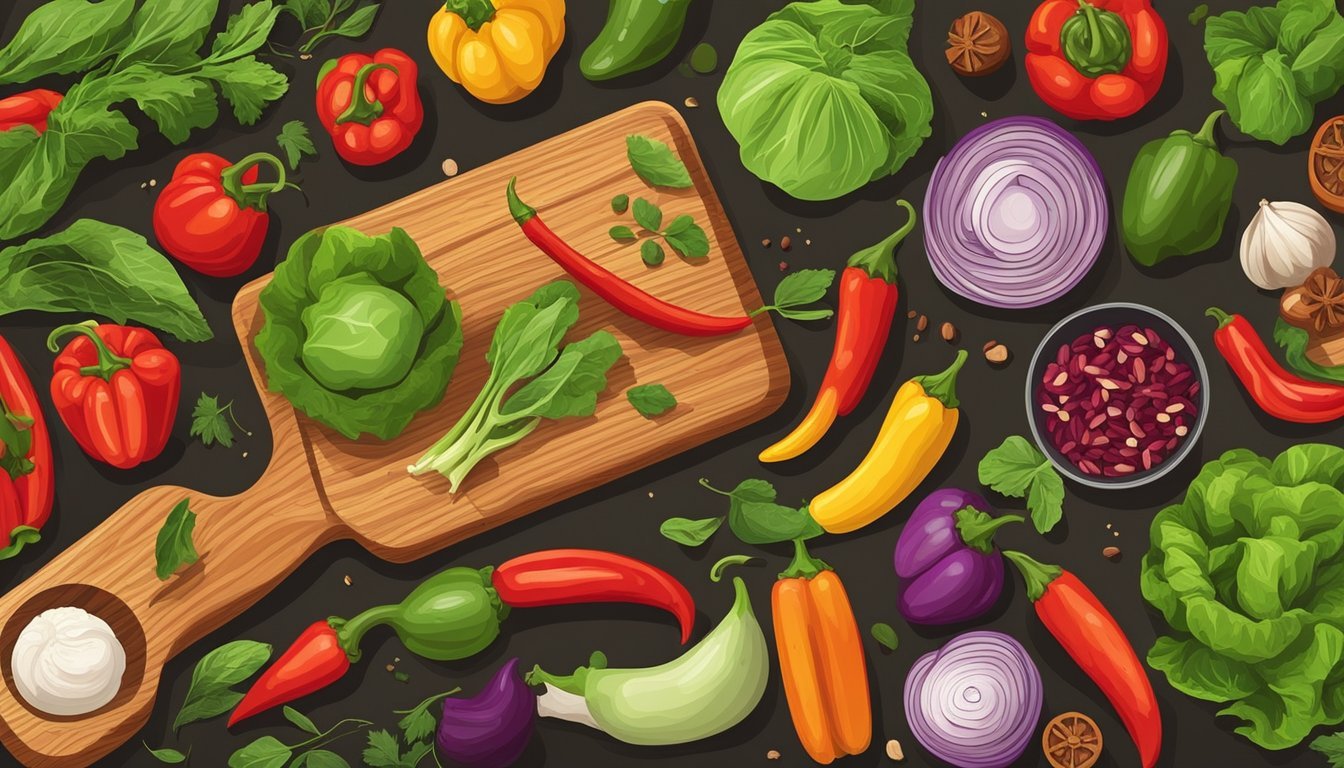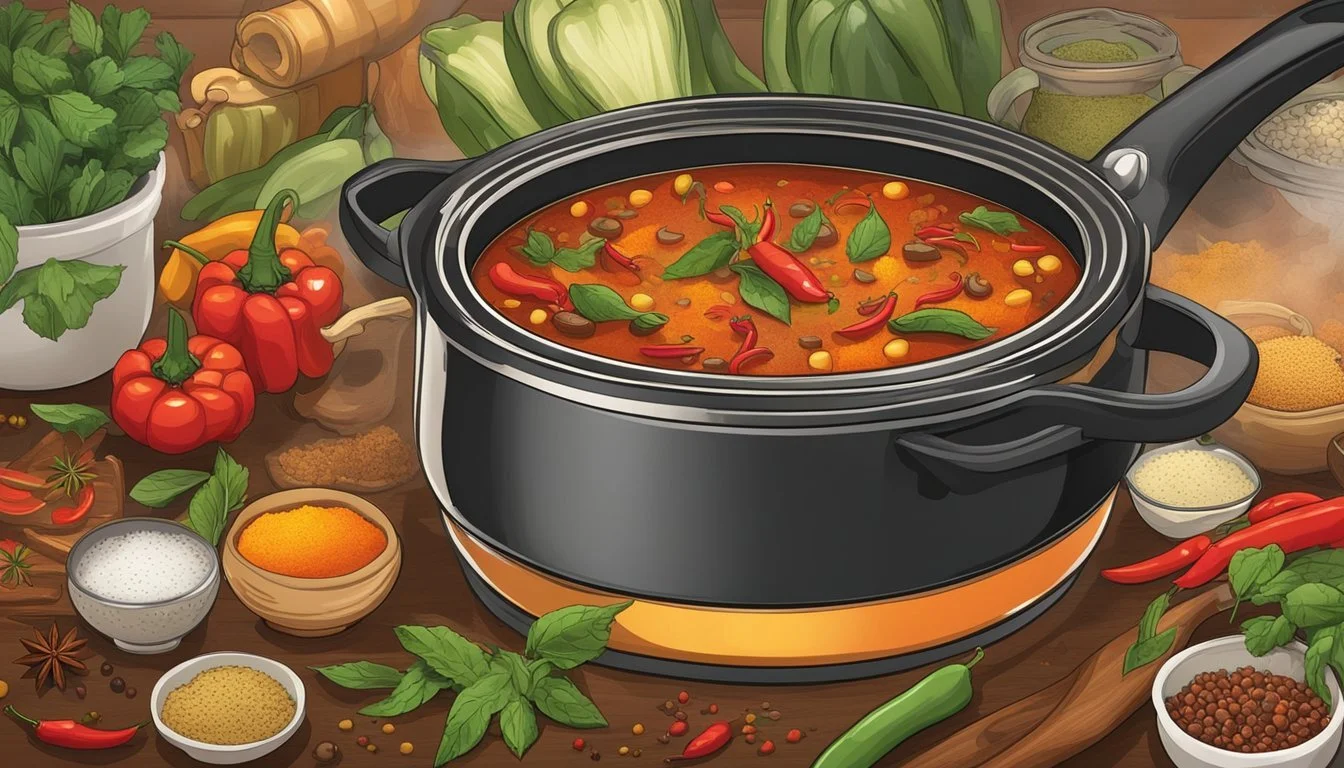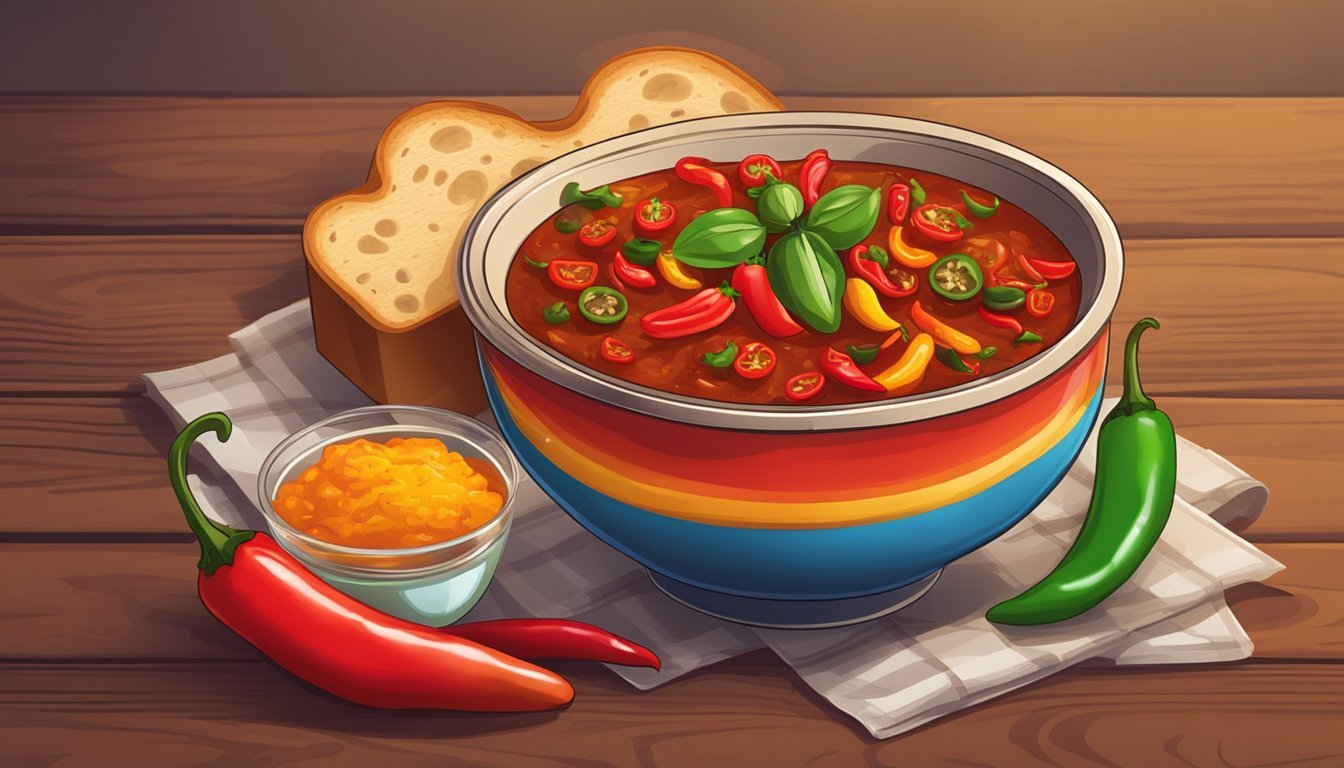The Spiciest Chili Recipes
Discover Your Ultimate Hearty and Fiery Dish
A steaming bowl of chili epitomizes comfort food, especially when it packs a punch of heat. For those who love a meal that tingles the taste buds, the spiciest chili recipes are culinary treasures. These fiery variations of the classic dish are not just about the scorching sensation; they also offer a medley of flavors that showcase a careful balance of ingredients. Ground meats, robust beans, and an assortment of spices come together to create a hearty chili that warms from the inside out.
In crafting the spiciest chili, cooks often reach for heat sources like jalapeños, Anaheim peppers, and crushed red pepper flakes, which are integral to achieving that desirable zing. The type of protein used is frequently diversified, from ground turkey to beef, while a mixture of beans adds texture and substance. Cooking methods vary as well, with some recipes harnessing the convenience of pressure cookers and slow cookers to meld the flavors over several hours.
Chili aficionados know that the secret to a great spicy chili lies in the combination of spices and layering of flavors. Traditional chili powder, cumin, and oregano provide a familiar base, whereas additions like brown sugar can offer a subtle sweetness to counterbalance the heat. The result is a complex and satisfying dish that's both an art and a science, cheering the senses on cold evenings or when one simply craves a bold and spirited meal.
History and Origins
The genesis of chili recipes is a tapestry woven from various cultural threads, particularly those of Mexican and Texan origins. It is believed that the first detailed mention of chili dates to an 1828 journal entry by J. C. Clopper, who encountered the dish in San Antonio. It was described primarily as a meat hash fortified with a generous amount of peppers.
In the late 19th century, San Antonio, Texas emerged as a pivotal point in the evolution of chili. Informally dubbed "chili queens," local street vendors captivated residents and visitors alike with their aromatic and spicy stews. These women were integral in popularizing what would become known as chili con carne, a stew of meat and chili peppers, at their open-air stands.
Ingredient Role in Chili Chili Powder Adds depth and heat Spices Enhances flavor complexity
Chili powder and a blend of spices provide chili with its distinctive, fiery taste. Not to be confused with cayenne pepper or other singular ground chiles, chili powder is a blend, which may include garlic powder, cumin, oregano, and other spices tailored to the cook's preference. This concoction is pivotal in achieving the characteristic heartiness and palatable fire in chili recipes.
As for its geographical origins, chili con carne is firmly rooted in the American Southwest, particularly Texas, where it has transitioned from street food to a staple, gaining traction across the United States. Its widespread appeal can be partially attributed to the 1893 Columbian Exposition in Chicago, where Texas introduced the dish to a broader audience.
In sum, chili's heritage is a storied affair, starting from indigenous practices, flourishing through Texan influence, and eventually being embraced by the nation as a comfort dish that balances the heat of chili powder with a medley of spices and hearty meat.
Choosing the Right Ingredients
The foundation of a spicy chili lies in the selection of quality ingredients, each component contributing to the heat and heartiness of the dish.
Meats: From Ground Beef to Turkey
When it comes to meats, ground beef remains a classic choice due to its rich flavor and satisfying texture. Alternatively, ground turkey can be used for a leaner option without compromising the chili's heartiness. The key is to brown the meat properly to unlock its full potential.
Beans and Legumes: A Versatile Component
Beans are a staple in chili recipes, both for their texture and their ability to absorb flavors. Key players include:
Kidney beans: Dark red for a robust flavor and firmer bite.
Pinto beans: Slightly creamy and ideal for soaking up spices.
Black beans: Known for their earthy taste.
One must rinse canned beans to remove excess sodium before adding them to the chili.
Vegetables: Onions, Peppers, and More
Vegetables add depth to chili, starting with the essential onion, which should be sautéed until soft. Bell peppers (What wine goes well with bell peppers?) and jalapeños offer a contrast in sweetness and heat, while tomatoes, whether diced or crushed, contribute a necessary acidity to balance the dish.
Herbs and Spices: Building Layers of Flavor
Proper seasoning is crucial. Start with:
Salt and pepper for basic seasoning.
Cumin and oregano for that classic chili profile.
A variety of chili spices including chili powder and cayenne, which give the dish its signature heat.
Garlic, which should be added with care to prevent bitterness.
Balance the heat with the richness of the beans and meat, and build layers of flavor carefully for the best results.
Preparation Techniques
In crafting the spiciest chili recipes, one's approach to preparation plays a critical role. Whether simmering on the stovetop, harnessing the power of the Instant Pot, or letting flavors meld in a slow cooker, each technique can elevate the chili to new heights of flavor and spice.
Mastering the Art of Simmering
Simmering is a fundamental technique where one cooks the chili slowly, over low heat. This method allows for the development of deep flavors as the ingredients meld together. Chili aficionados often simmer for several hours, stirring occasionally to ensure even cooking and prevent sticking.
Instant Pot Chili for Modern Cooks
Instant Pot chili revolutionizes the cooking process, delivering robust flavors in a fraction of the time. To utilize the Instant Pot effectively, one must first sauté the onions, garlic, and ground meat using the sauté function, ensuring these foundational ingredients are well-browned. Next, they add the spices, tomato products, beans, and broth, then set the Instant Pot to pressure cook, typically for around 20 minutes, before allowing a natural release.
Slow Cooker Methods for Richness and Depth
Slow cooker chili exemplifies the set-it-and-forget-it approach, ideal for busy cooks seeking flavor without fuss. One combines all ingredients in the slow cooker, setting it on low for 7-8 hours or on high for 3-4 hours. This gentle cooking process allows heat to permeate evenly, resulting in a chili with a rich, velvety texture and complex layers of heat and seasoning.
In each preparation method, the incorporation of a variety of spices and, optionally, a dollop of sour cream upon serving can balance the heat of the soup while enhancing its creaminess and complexity.
Regional Variations
Chili is a diverse dish with regional variations that bring their own unique flavors and ingredients to the table, ranging from meat-heavy Texas styles to lighter chicken versions and hearty vegetarian options.
Texas-Style Chili: Bold and Meat-Driven
In Texas, chili is a proud staple with a focus on meat; beans are often omitted. Texas-style chili typically includes chunks of beef, such as brisket or shoulder, rather than ground meat. It's seasoned with cumin, chili powder, and often enhanced with onions, garlic, and chilies like jalapeños to add depth and heat.
White Chicken Chili: A Lighter Take
White chicken chili offers a lighter option. It uses ground chicken or shredded white meat and melds it with white beans, embodying a gentler spice profile. The dish frequently incorporates green chilies, and it's finished with garnishes such as sour cream and fresh herbs.
Vegetarian Chili: Full of Flavor and Nutrition
Vegetarian chili (What wine goes well with vegetarian chili?) boasts a plethora of nutrient-dense ingredients, making it both healthful and satisfying. A variety of beans—such as kidney, black, and pinto—form the protein-packed base. Tomatoes, corn, and bell peppers add sweetness and texture, while spices like cumin and chili powder ensure rich flavor.
Nutritional Information
In examining the spiciness of chili recipes, it's essential to understand the nutritional profile of their ingredients. This insight can help gauge the health benefits or considerations one must account for when indulging in these hearty dishes.
Caloric Content of Common Ingredients
Ground Chicken: A popular lean protein choice for chili, ground chicken typically contains around 120-160 calories per 4-ounce serving, with minimal saturated fat and no carbohydrates. It also offers a good amount of protein, roughly 22 grams, which is vital for muscle repair and growth.
Beans: Beans are a staple in many chili recipes, adding both texture and nutrition. A 1/2-cup serving of kidney beans averages about 120 calories, with less than 1 gram of fat and a significant amount of fiber, usually around 7 grams, which aids in digestion. Beans are also a good source of protein, potassium, and iron.
Vegetables: Onions and bell peppers are frequently used for flavor and bulk, contributing minimal calories (around 25-45 calories per 1/2 cup) but delivering high levels of vitamin C and fiber. They are also low in fat and cholesterol.
Chili Powder: This spice mix is negligible in calories but is high in vitamin A and some minerals like potassium, adding depth to the flavor profile without contributing significantly to the caloric intake.
Olive Oil: Often used for sautéing ingredients, olive oil is a healthier fat option. A teaspoon contains about 40 calories and is rich in monounsaturated fats, known for their heart-healthy properties.
Here's a quick glance at the nutritional content of these common chili ingredients:
Ingredient Calories (per serving) Protein (g) Carbohydrates (g) Fat (g) Fiber (g) Vitamin C (%) Potassium (mg) Cholesterol (mg) Ground Chicken 140 22 0 6 0 0 - 70 Kidney Beans 120 8 22 1 7 - 370 0 Onions 40 1 10 0 2 20% 145 0 Bell Peppers 25 1 6 0 2 190% 175 0 Chili Powder 8 0 1 0.4 0.8 2% 56 0 Olive Oil 40 (per tsp) 0 0 4.5 0 0 0 0
Note: Vitamin C percentage is based on Recommended Dietary Allowance (RDA) for adults. The potassium amount is in milligrams (mg).
While the caloric content can vary based on the quantities and specific ingredients used, most chili recipes can offer a balance of nutrients with careful portioning. Key considerations include managing sodium from canned ingredients and balancing saturated fat intake if higher-fat meats are used.
Serving Suggestions
When crafting the perfect bowl of spicy chili, the accompaniments play a critical role in balancing flavors and textures. Here are some definitive suggestions for what to serve alongside your fiery creation.
Perfect Pairings with Cornbread and Toppings
Cornbread: A classic partner for chili is a piece of warm, buttery cornbread. The sweetness of the cornbread complements the heat of the chili, providing a soothing contrast.
Classic Yellow Cornbread: Ideal for soaking up the robust flavors.
Jalapeño Cheddar Cornbread: For those who crave an extra kick, add diced jalapeño and shredded cheese to the batter before baking.
A variety of toppings allows guests to customize their bowl of chili to their liking. Here's a breakdown of popular toppings that enhance both flavor and texture:
Toppings Description Shredded Cheese Adds a creamy, melty layer on top of the hot chili. Diced Avocado Provides a cool and creamy contrast to the spice. Cilantro Offers a fresh, herby note that brightens the heavy dish. Sliced Jalapeños Introduces additional heat for spice enthusiasts. Tortilla Chips Adds a delightful crunch; can also be used to scoop the chili. Rice Serves as a hearty base that absorbs the chili's flavors.
Remember to lay out these toppings in a buffet-style spread, allowing for a fun and interactive meal experience. Each guest can tailor their chili to hit the perfect balance of spicy, refreshing, and satisfying according to their taste.
Storage and Make-Ahead Tips
When it comes to making spicy chili, one can prepare the dish ahead of time, and the flavors often meld together more intensely after resting. For successful make-ahead tips, chili enthusiasts should consider the following:
Chill: Always allow the chili to cool to room temperature before storing.
Refrigeration: In an airtight container, chili can be stored in the fridge for 3 to 4 days.
Freezing: To freeze chili, portion it into freezer-safe bags or containers. Leave an inch of space to allow for expansion.
Thawing and Reheating Instructions:
Thaw: Ideally, thaw frozen chili in the refrigerator overnight.
Reheat: Warm the chili on the stove over medium heat, stirring occasionally, until heated through.
Action Instruction Duration Make-Ahead Cool, transfer to container, cover, refrigerate. Prepare 1-2 days prior Storing Seal in an airtight container, refrigerate. 3-4 days in fridge Freezing Portion, leave space in container, seal, label with date, freeze. Up to 3 months
Remember, always use clean utensils when serving to maintain freshness, and freeze in small portions if reheating only a single serving is anticipated. This approach ensures the chili maintains its quality and reduces food waste.
Innovative Twists
Chili enthusiasts often seek new ways to elevate the heat and flavor of their classic dish. Adding specialty hot sauces or incorporating fiery ingredients can transform traditional chili into a bold and innovative experience.
Adding a Kick with Hot Sauce and Spicy Elements
When crafting a spicy chili recipe, chefs focus on integrating heat without overpowering the blend of flavors. Hot sauce selection is crucial — a sauce with a depth of flavor, like one that has been aged or features smoke-infused peppers, can add complexity. Notable hot sauces can include those made with cayenne or habanero, which lend a distinct burn to the dish.
Ingredients to enhance the spice profile:
Hot Sauces: A dash can significantly increase heat.
Cayenne-based sauces: Adds a steady, fiery taste.
Habanero-infused varieties: Imparts a fruity yet intense heat.
Chili Peppers and Flakes: Use sparingly to complement the main ingredients without overwhelming.
Crushed red pepper: Delivers a sharp, moderate heat.
Diced jalapeños: Provide a milder heat with a green, vegetal note.
For an autumnal twist, one might consider integrating pumpkin into chili, which provides a sweet and earthy counterbalance to the spiciness. A pumpkin chili can surprise the palate, especially when the pumpkin's sweetness is juxtaposed with the robust heat of fire-roasted tomatoes and a bold spice mix.
Enhancing the heat of the chili with beer can also yield delicious results. A dark or hoppy beer can introduce a nuanced bitterness, and the alcoholic content helps to marry the flavors. Some chili aficionados choose to simmer their blend with a bottle of their favorite brew, both for the taste and the tenderizing effect it has on the meat.
By utilizing specific types of heat, one can control the spice level, creating a symphony of flavors. Whether incorporating fire-roasted tomatoes for a smoky tang or sprinkling cayenne for a steady burn, these ingredients ensure each spoonful of spicy chili is satisfyingly intense.








